Nursing OSCA Exam Reflection: IV Fluid Priming and Dosage
VerifiedAdded on 2020/06/04
|6
|1138
|494
Report
AI Summary
This report is a critical reflection on a student's experience with an Objective Structured Clinical Assessment (OSCA) exam, specifically focusing on the practical component of priming an IV fluid, connecting a cannula to a patient, and calculating the correct dosage using an infusion pump. The student utilizes the Gibbs cycle of reflection to analyze the experience, detailing the events, their thoughts and feelings during the assessment, and the meaning derived from the experience. The analysis covers preparation, the procedure itself, and the challenges faced, such as explaining the process to the patient. The conclusion emphasizes the need for increased self-confidence and enhanced knowledge to improve performance. An action plan outlines steps to enhance knowledge, reduce patient stay duration, and minimize infection and phlebitis, aligning with the Nursing and Midwifery Board of Australia (NMBA) competency standards and code of conduct. References include relevant journal articles and online resources.
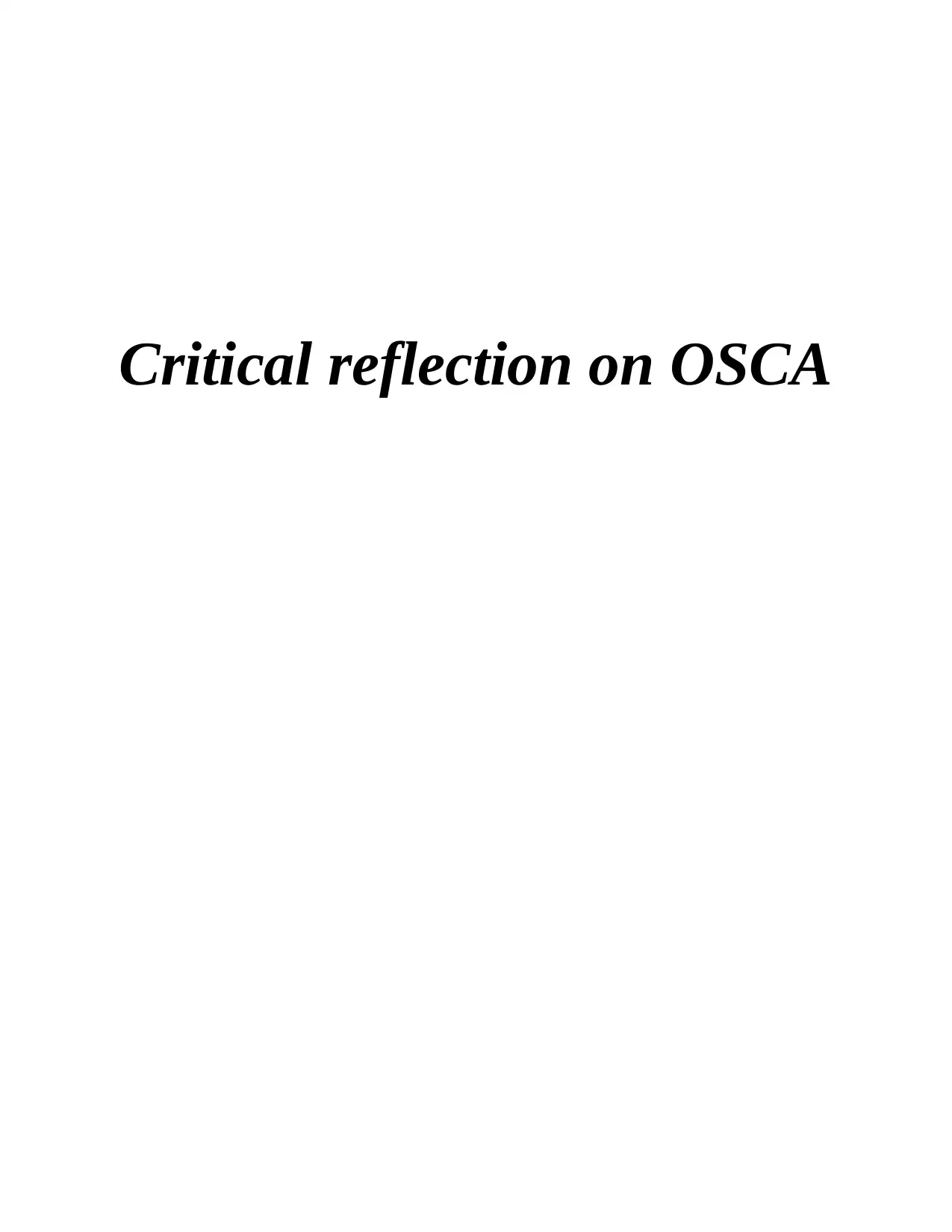
Critical reflection on OSCA
Paraphrase This Document
Need a fresh take? Get an instant paraphrase of this document with our AI Paraphraser
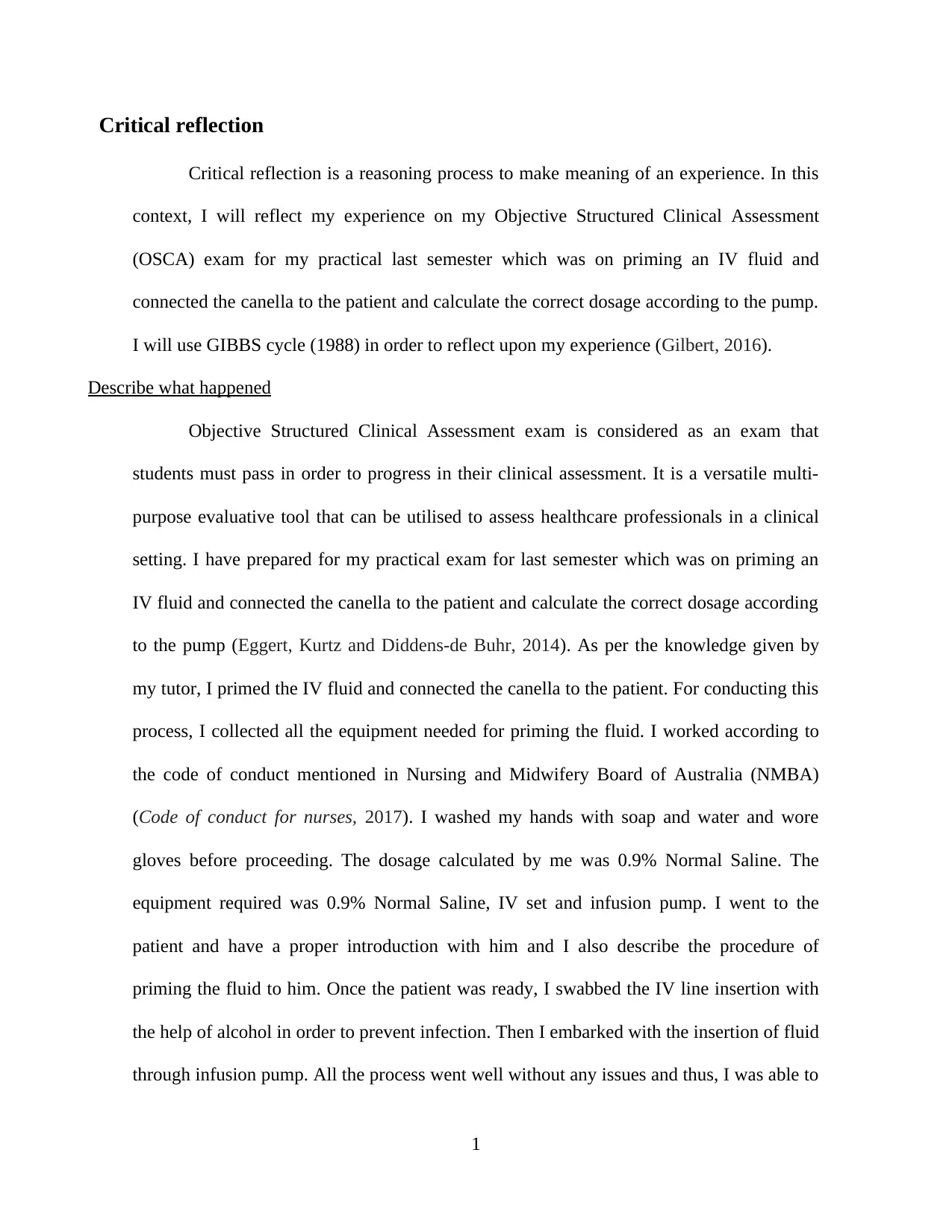
Critical reflection
Critical reflection is a reasoning process to make meaning of an experience. In this
context, I will reflect my experience on my Objective Structured Clinical Assessment
(OSCA) exam for my practical last semester which was on priming an IV fluid and
connected the canella to the patient and calculate the correct dosage according to the pump.
I will use GIBBS cycle (1988) in order to reflect upon my experience (Gilbert, 2016).
Describe what happened
Objective Structured Clinical Assessment exam is considered as an exam that
students must pass in order to progress in their clinical assessment. It is a versatile multi-
purpose evaluative tool that can be utilised to assess healthcare professionals in a clinical
setting. I have prepared for my practical exam for last semester which was on priming an
IV fluid and connected the canella to the patient and calculate the correct dosage according
to the pump (Eggert, Kurtz and Diddens-de Buhr, 2014). As per the knowledge given by
my tutor, I primed the IV fluid and connected the canella to the patient. For conducting this
process, I collected all the equipment needed for priming the fluid. I worked according to
the code of conduct mentioned in Nursing and Midwifery Board of Australia (NMBA)
(Code of conduct for nurses, 2017). I washed my hands with soap and water and wore
gloves before proceeding. The dosage calculated by me was 0.9% Normal Saline. The
equipment required was 0.9% Normal Saline, IV set and infusion pump. I went to the
patient and have a proper introduction with him and I also describe the procedure of
priming the fluid to him. Once the patient was ready, I swabbed the IV line insertion with
the help of alcohol in order to prevent infection. Then I embarked with the insertion of fluid
through infusion pump. All the process went well without any issues and thus, I was able to
1
Critical reflection is a reasoning process to make meaning of an experience. In this
context, I will reflect my experience on my Objective Structured Clinical Assessment
(OSCA) exam for my practical last semester which was on priming an IV fluid and
connected the canella to the patient and calculate the correct dosage according to the pump.
I will use GIBBS cycle (1988) in order to reflect upon my experience (Gilbert, 2016).
Describe what happened
Objective Structured Clinical Assessment exam is considered as an exam that
students must pass in order to progress in their clinical assessment. It is a versatile multi-
purpose evaluative tool that can be utilised to assess healthcare professionals in a clinical
setting. I have prepared for my practical exam for last semester which was on priming an
IV fluid and connected the canella to the patient and calculate the correct dosage according
to the pump (Eggert, Kurtz and Diddens-de Buhr, 2014). As per the knowledge given by
my tutor, I primed the IV fluid and connected the canella to the patient. For conducting this
process, I collected all the equipment needed for priming the fluid. I worked according to
the code of conduct mentioned in Nursing and Midwifery Board of Australia (NMBA)
(Code of conduct for nurses, 2017). I washed my hands with soap and water and wore
gloves before proceeding. The dosage calculated by me was 0.9% Normal Saline. The
equipment required was 0.9% Normal Saline, IV set and infusion pump. I went to the
patient and have a proper introduction with him and I also describe the procedure of
priming the fluid to him. Once the patient was ready, I swabbed the IV line insertion with
the help of alcohol in order to prevent infection. Then I embarked with the insertion of fluid
through infusion pump. All the process went well without any issues and thus, I was able to
1
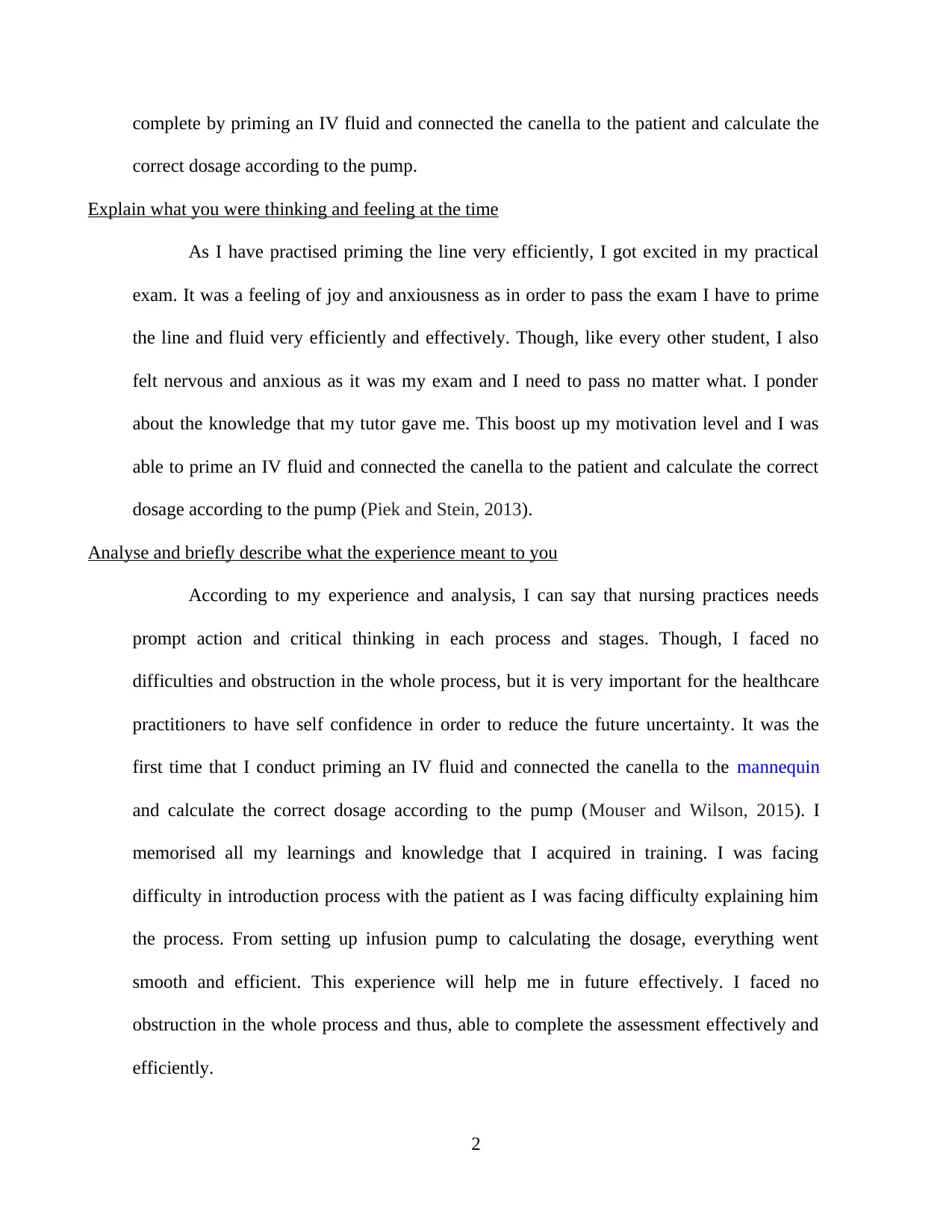
complete by priming an IV fluid and connected the canella to the patient and calculate the
correct dosage according to the pump.
Explain what you were thinking and feeling at the time
As I have practised priming the line very efficiently, I got excited in my practical
exam. It was a feeling of joy and anxiousness as in order to pass the exam I have to prime
the line and fluid very efficiently and effectively. Though, like every other student, I also
felt nervous and anxious as it was my exam and I need to pass no matter what. I ponder
about the knowledge that my tutor gave me. This boost up my motivation level and I was
able to prime an IV fluid and connected the canella to the patient and calculate the correct
dosage according to the pump (Piek and Stein, 2013).
Analyse and briefly describe what the experience meant to you
According to my experience and analysis, I can say that nursing practices needs
prompt action and critical thinking in each process and stages. Though, I faced no
difficulties and obstruction in the whole process, but it is very important for the healthcare
practitioners to have self confidence in order to reduce the future uncertainty. It was the
first time that I conduct priming an IV fluid and connected the canella to the mannequin
and calculate the correct dosage according to the pump (Mouser and Wilson, 2015). I
memorised all my learnings and knowledge that I acquired in training. I was facing
difficulty in introduction process with the patient as I was facing difficulty explaining him
the process. From setting up infusion pump to calculating the dosage, everything went
smooth and efficient. This experience will help me in future effectively. I faced no
obstruction in the whole process and thus, able to complete the assessment effectively and
efficiently.
2
correct dosage according to the pump.
Explain what you were thinking and feeling at the time
As I have practised priming the line very efficiently, I got excited in my practical
exam. It was a feeling of joy and anxiousness as in order to pass the exam I have to prime
the line and fluid very efficiently and effectively. Though, like every other student, I also
felt nervous and anxious as it was my exam and I need to pass no matter what. I ponder
about the knowledge that my tutor gave me. This boost up my motivation level and I was
able to prime an IV fluid and connected the canella to the patient and calculate the correct
dosage according to the pump (Piek and Stein, 2013).
Analyse and briefly describe what the experience meant to you
According to my experience and analysis, I can say that nursing practices needs
prompt action and critical thinking in each process and stages. Though, I faced no
difficulties and obstruction in the whole process, but it is very important for the healthcare
practitioners to have self confidence in order to reduce the future uncertainty. It was the
first time that I conduct priming an IV fluid and connected the canella to the mannequin
and calculate the correct dosage according to the pump (Mouser and Wilson, 2015). I
memorised all my learnings and knowledge that I acquired in training. I was facing
difficulty in introduction process with the patient as I was facing difficulty explaining him
the process. From setting up infusion pump to calculating the dosage, everything went
smooth and efficient. This experience will help me in future effectively. I faced no
obstruction in the whole process and thus, able to complete the assessment effectively and
efficiently.
2
⊘ This is a preview!⊘
Do you want full access?
Subscribe today to unlock all pages.

Trusted by 1+ million students worldwide
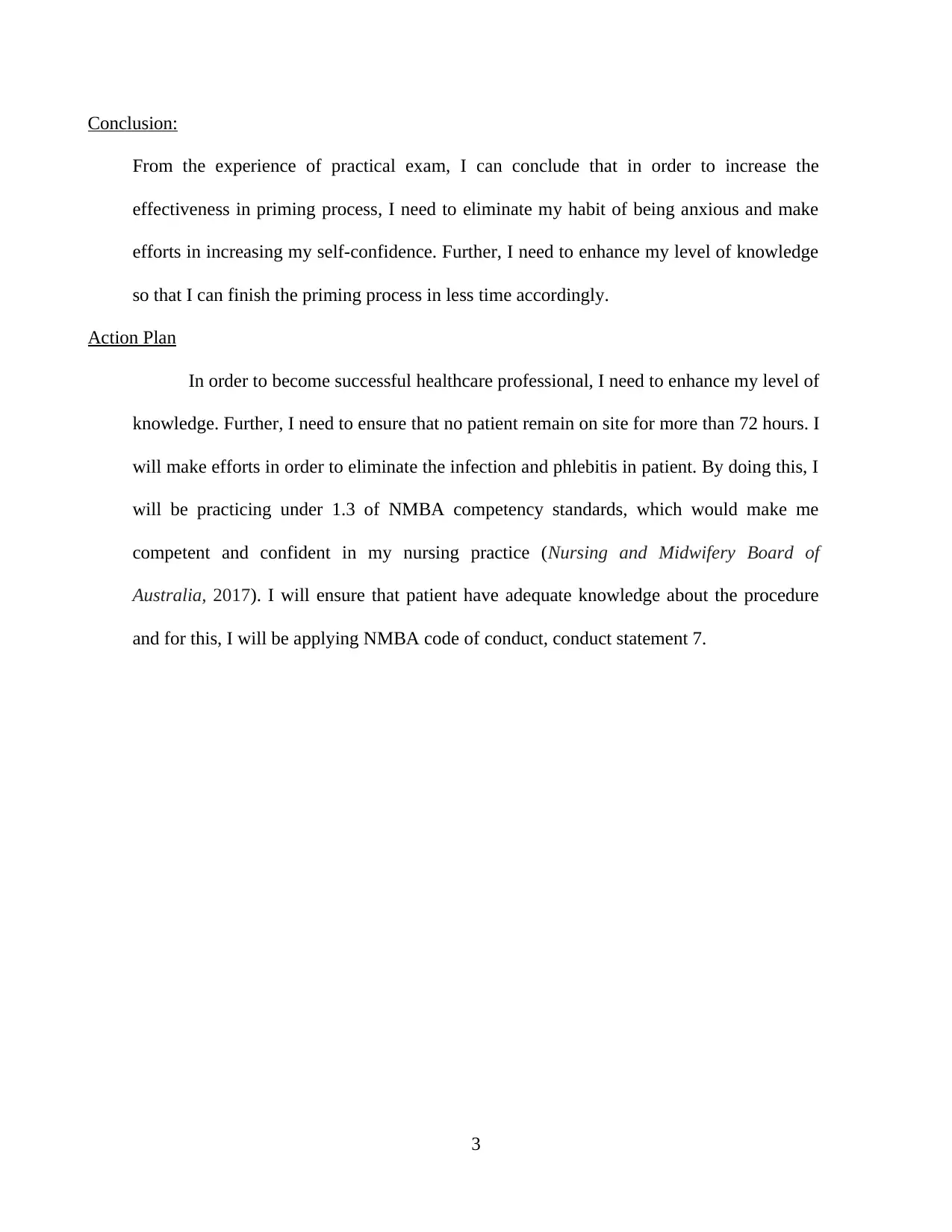
Conclusion:
From the experience of practical exam, I can conclude that in order to increase the
effectiveness in priming process, I need to eliminate my habit of being anxious and make
efforts in increasing my self-confidence. Further, I need to enhance my level of knowledge
so that I can finish the priming process in less time accordingly.
Action Plan
In order to become successful healthcare professional, I need to enhance my level of
knowledge. Further, I need to ensure that no patient remain on site for more than 72 hours. I
will make efforts in order to eliminate the infection and phlebitis in patient. By doing this, I
will be practicing under 1.3 of NMBA competency standards, which would make me
competent and confident in my nursing practice (Nursing and Midwifery Board of
Australia, 2017). I will ensure that patient have adequate knowledge about the procedure
and for this, I will be applying NMBA code of conduct, conduct statement 7.
3
From the experience of practical exam, I can conclude that in order to increase the
effectiveness in priming process, I need to eliminate my habit of being anxious and make
efforts in increasing my self-confidence. Further, I need to enhance my level of knowledge
so that I can finish the priming process in less time accordingly.
Action Plan
In order to become successful healthcare professional, I need to enhance my level of
knowledge. Further, I need to ensure that no patient remain on site for more than 72 hours. I
will make efforts in order to eliminate the infection and phlebitis in patient. By doing this, I
will be practicing under 1.3 of NMBA competency standards, which would make me
competent and confident in my nursing practice (Nursing and Midwifery Board of
Australia, 2017). I will ensure that patient have adequate knowledge about the procedure
and for this, I will be applying NMBA code of conduct, conduct statement 7.
3
Paraphrase This Document
Need a fresh take? Get an instant paraphrase of this document with our AI Paraphraser
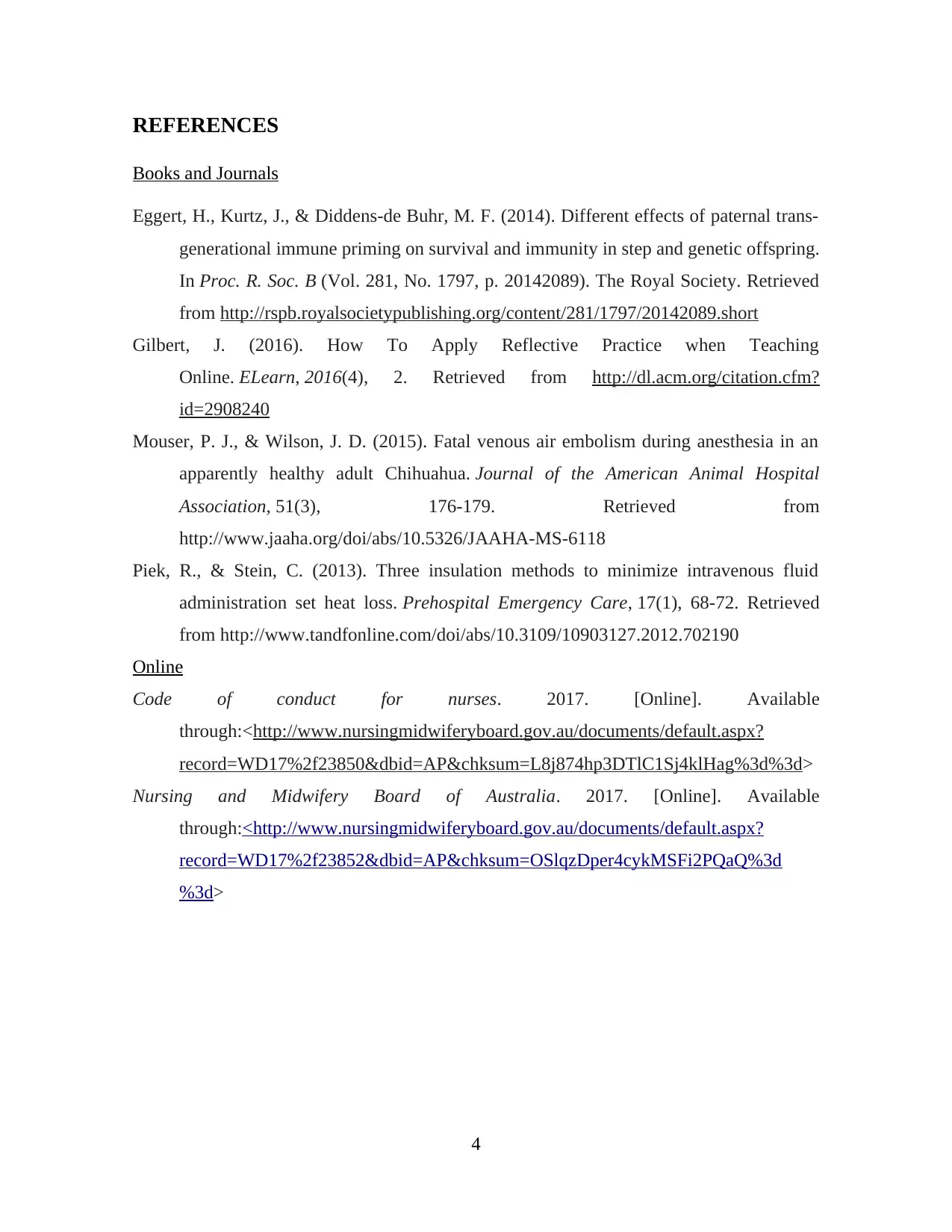
REFERENCES
Books and Journals
Eggert, H., Kurtz, J., & Diddens-de Buhr, M. F. (2014). Different effects of paternal trans-
generational immune priming on survival and immunity in step and genetic offspring.
In Proc. R. Soc. B (Vol. 281, No. 1797, p. 20142089). The Royal Society. Retrieved
from http://rspb.royalsocietypublishing.org/content/281/1797/20142089.short
Gilbert, J. (2016). How To Apply Reflective Practice when Teaching
Online. ELearn, 2016(4), 2. Retrieved from http://dl.acm.org/citation.cfm?
id=2908240
Mouser, P. J., & Wilson, J. D. (2015). Fatal venous air embolism during anesthesia in an
apparently healthy adult Chihuahua. Journal of the American Animal Hospital
Association, 51(3), 176-179. Retrieved from
http://www.jaaha.org/doi/abs/10.5326/JAAHA-MS-6118
Piek, R., & Stein, C. (2013). Three insulation methods to minimize intravenous fluid
administration set heat loss. Prehospital Emergency Care, 17(1), 68-72. Retrieved
from http://www.tandfonline.com/doi/abs/10.3109/10903127.2012.702190
Online
Code of conduct for nurses. 2017. [Online]. Available
through:<http://www.nursingmidwiferyboard.gov.au/documents/default.aspx?
record=WD17%2f23850&dbid=AP&chksum=L8j874hp3DTlC1Sj4klHag%3d%3d>
Nursing and Midwifery Board of Australia. 2017. [Online]. Available
through:<http://www.nursingmidwiferyboard.gov.au/documents/default.aspx?
record=WD17%2f23852&dbid=AP&chksum=OSlqzDper4cykMSFi2PQaQ%3d
%3d>
4
Books and Journals
Eggert, H., Kurtz, J., & Diddens-de Buhr, M. F. (2014). Different effects of paternal trans-
generational immune priming on survival and immunity in step and genetic offspring.
In Proc. R. Soc. B (Vol. 281, No. 1797, p. 20142089). The Royal Society. Retrieved
from http://rspb.royalsocietypublishing.org/content/281/1797/20142089.short
Gilbert, J. (2016). How To Apply Reflective Practice when Teaching
Online. ELearn, 2016(4), 2. Retrieved from http://dl.acm.org/citation.cfm?
id=2908240
Mouser, P. J., & Wilson, J. D. (2015). Fatal venous air embolism during anesthesia in an
apparently healthy adult Chihuahua. Journal of the American Animal Hospital
Association, 51(3), 176-179. Retrieved from
http://www.jaaha.org/doi/abs/10.5326/JAAHA-MS-6118
Piek, R., & Stein, C. (2013). Three insulation methods to minimize intravenous fluid
administration set heat loss. Prehospital Emergency Care, 17(1), 68-72. Retrieved
from http://www.tandfonline.com/doi/abs/10.3109/10903127.2012.702190
Online
Code of conduct for nurses. 2017. [Online]. Available
through:<http://www.nursingmidwiferyboard.gov.au/documents/default.aspx?
record=WD17%2f23850&dbid=AP&chksum=L8j874hp3DTlC1Sj4klHag%3d%3d>
Nursing and Midwifery Board of Australia. 2017. [Online]. Available
through:<http://www.nursingmidwiferyboard.gov.au/documents/default.aspx?
record=WD17%2f23852&dbid=AP&chksum=OSlqzDper4cykMSFi2PQaQ%3d
%3d>
4

5
⊘ This is a preview!⊘
Do you want full access?
Subscribe today to unlock all pages.

Trusted by 1+ million students worldwide
1 out of 6
Related Documents
Your All-in-One AI-Powered Toolkit for Academic Success.
+13062052269
info@desklib.com
Available 24*7 on WhatsApp / Email
![[object Object]](/_next/static/media/star-bottom.7253800d.svg)
Unlock your academic potential
Copyright © 2020–2025 A2Z Services. All Rights Reserved. Developed and managed by ZUCOL.



